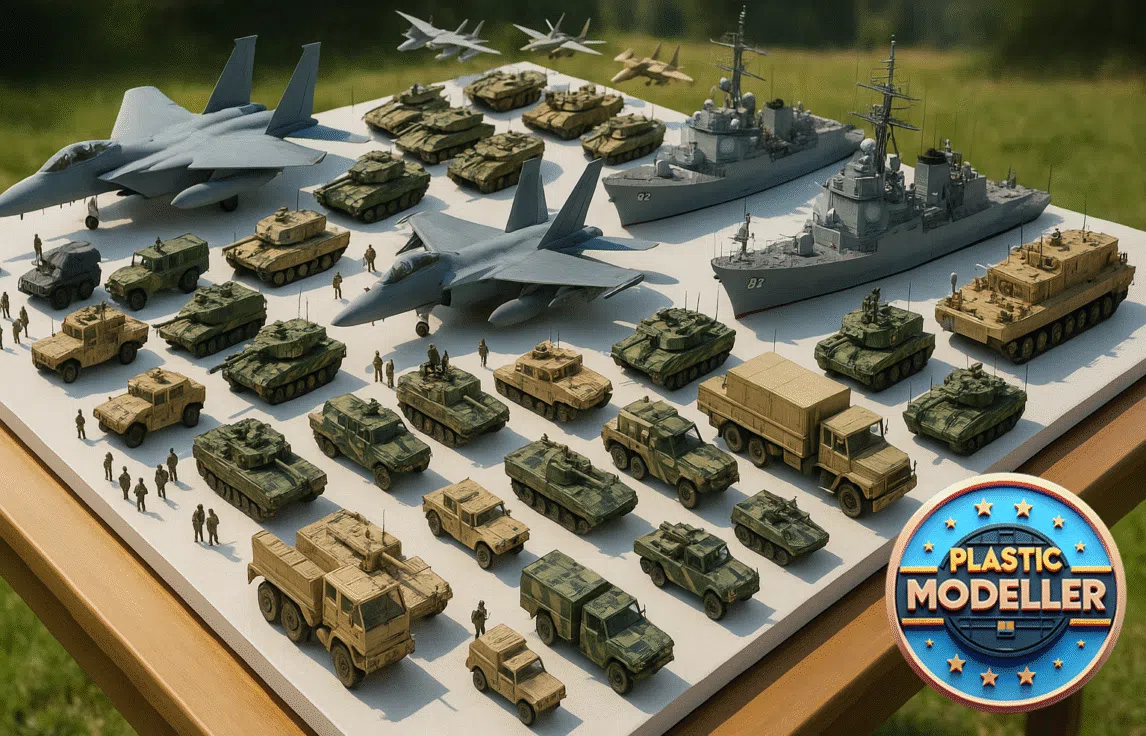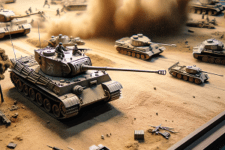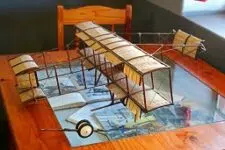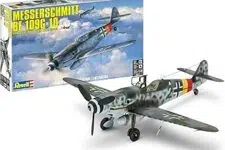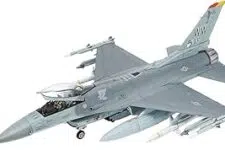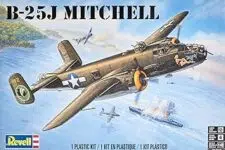Table of Contents
The F22 Raptor model kit is a satisfaction to construct. Know the development behind this sophisticated machine.
The F22 Raptor is a fifth-generation fighter jet designed primarily for air superiority by the United States Air Force. It was intended to be a replacement for the aging F15 Eagle, which was becoming increasingly vulnerable to newer aircraft and air defense systems.
F22, A Sophisticated Stealthy Fighter Jet
The F22 Raptor was developed in the 1980s with the goal of developing a stealthy, highly maneuverable fighter capable of evading radar detection and engaging enemy aircraft in air-to-air combat. The aircraft is outfitted with cutting-edge avionics, sensors, and weapons systems that allow it to detect, track, and engage multiple targets at long ranges and in all weather conditions.
The F22 Raptor was also designed to have a low radar cross-section, making it difficult for enemy radar systems to detect it, and it can fly at supersonic speeds without afterburners, allowing it to engage and disengage quickly from enemy fighters. If building an F22 Raptor model kit, take note of all the details.

The F22 Raptor is capable of ground attack missions in addition to air superiority and has been used in combat in Iraq and Syria. Overall, the F22 Raptor is regarded as one of the world’s most advanced and capable fighter jets, and it plays an important role in the United States air defense strategy.
The F-22 Raptor’s Design Process
The F-22 Raptor design process included several stages, including conceptual design, preliminary design, detailed design, and testing. The following are the basic stages of the F22 Raptor’s design:
The Air Force developed several conceptual designs for the F22 Raptor in its early stages. These designs were evaluated based on factors such as performance, cost, and feasibility.
Preliminary Design: After selecting a conceptual design, engineers began to refine the design in a process known as preliminary design. This stage entailed creating detailed drawings and computer models of the aircraft, as well as conducting wind tunnel tests and other simulations to evaluate its performance.
Engineers moved on to the detailed design stage after completing the preliminary design. This included creating detailed engineering drawings and specifications, selecting materials and manufacturing processes, and creating an aircraft prototype.
Testing: After the prototype was built, it went through extensive testing to evaluate its performance and make any necessary changes. This included flight tests, weapons testing, and other evaluations to ensure the aircraft met the Air Force’s requirements.
The final shape of the F22 Raptor reflects its design goals of high performance, stealth, and maneuverability. The aircraft has a sleek, angular design with a triangular wing shape, a single vertical tail fin, and two engine exhausts that are angled outwards to reduce its infrared signature. The shape of the F 22 Raptor also incorporates various features to reduce its radar signatures, such as radar-absorbing materials and a design that minimizes radar reflectivity. Overall, the F 22 Raptor’s design is optimized for maximum performance and survivability in air-to-air combat.
What Roles Has The F-22 Raptor Done During Its Years Of Service?
The F22 Raptor has been primarily used by the United States Air Force for air superiority missions since its introduction in 2005, though it is also capable of performing ground attack missions. Here are some of the roles that the F22 Raptor has played over the years:
The F22 Raptor was designed to be a superior air-to-air combat aircraft. Because of its advanced avionics, sensors, and weapons systems, it can detect, track, and engage multiple targets at long ranges and in all weather conditions.
Suppression of Enemy Air Defenses (SEAD): By destroying or disabling ground-based air defense systems and radars, the F-22 Raptor can be used to suppress enemy air defenses.
Offensive Counter-Air (OCA) Missions: The F22 Raptor can be used for offensive counter-air missions, which involve destroying enemy aircraft and air defense systems in order to gain control of the airspace.
Close Air Support (CAS): Although the F22 Raptor was designed primarily for air-to-air combat, it can also perform ground attack missions. By attacking enemy ground targets with precision-guided munitions, it can provide close air support to friendly ground forces.
Overall, the F22 Raptor is a highly adaptable aircraft capable of a variety of missions, though its primary role remains air superiority.
Based on the arenas mentioned above, incorporating an F22 Raptor model kit would be a fun diorama to construct.
How Do Naysayers Feel About The F22 Raptor? What Are The F-22 Raptor’s Benefits and Drawbacks?
The F22 Raptor has received both praise and criticism. Here are some of the arguments advanced by both critics and supporters of the F-22 Raptor:
Arguments of the Critics:
The F22 Raptor is one of the most expensive fighter jets ever produced, with an estimated cost of more than $400 million per aircraft. Some critics argue that the aircraft’s high price is not justified given the current threats to the United States.
Maintenance: The F 22 Raptor requires extensive maintenance and support, which can be difficult and costly. Some critics argue that the aircraft’s high maintenance requirements and low readiness rates make it less effective in combat.
Some critics argue that the F22 Raptor’s focus on air-to-air combat is no longer relevant given the rise of unmanned aerial systems and the changing nature of modern warfare.
Export Restrictions: The United States has restricted the export of the F22 Raptor, which some critics argue limits the country’s ability to form partnerships and alliances with other countries.
Arguments of Supporters:
Superiority: The F22 Raptor is widely regarded as one of the most advanced and capable fighter jets ever produced. Its advanced avionics, sensors, and weapons systems give it a significant advantage in air-to-air combat.
The F22 Raptor has a low radar cross-section, making it difficult to detect by enemy radar systems. This gives the aircraft a significant advantage in air-to-air combat and allows it to enter enemy airspace undetected.
Survivability: The F 22 Raptor’s advanced design and technology make it highly survivable in combat. Its agility, speed, and maneuverability allow it to evade enemy attacks and engage multiple targets at the same time.
Multi-Role: While the F22 Raptor was primarily designed for air-to-air combat, it is also capable of performing ground attack missions, making it a highly versatile aircraft.
Overall, the F22 Raptor is a highly advanced and capable fighter jet with both strengths and weaknesses. Its high cost, maintenance requirements, and mission relevance have been criticized, while its superiority, stealth, survivability, and multi-role capabilities have been praised. Why not build an f22 Raptor model kit?
The Enthusiasm For F22 Raptor Model Kit Construction
Building an F22 Raptor model kit can be a fun and rewarding hobby for aviation enthusiasts and modelers of all ages. Here are some of the reasons why building an F22 Raptor model kit can be a fun and rewarding activity:
Building an F22 Raptor model kit allows one to appreciate the engineering and technology behind the aircraft. It can be a great way to learn about the aircraft’s design, structure, and mechanics, as well as the history and development of military aviation.
Attention to Detail: Building a model kit necessitates a high level of attention to detail and precision. Assembling the intricate parts of the aircraft, painting and decorating it, and bringing it to life in three dimensions can be a rewarding and challenging experience.
Building an F22 Raptor model kit can be a creative and artistic outlet. Models can choose to customize and personalize their models, experiment with different colors and finishes, and showcase their individuality and style.
Completing an F22 Raptor model kit can be a satisfying and fulfilling achievement. It can be a great sense of accomplishment to see the finished product and know that it was made with one’s own hands.
F22 Raptor model kit Camouflage Colors
The camouflage colors for the F22 Raptor model kit typically depend on the specific variant being modeled, as well as the time period and location in which it was deployed.
The most common colors used for the F22 Raptor model kit are shades of gray, as this helps to provide the necessary camouflage for the aircraft when flying at high altitudes. These colors may include light gray, dark gray, and even some black accents to help break up the plane’s silhouette.
Other possible colors may include a mix of greens and browns, especially for models that are meant to represent the aircraft during deployments in more forested or tropical regions. It’s important to note that different F22 Raptor model kit manufacturers may offer different color schemes, so it’s always a good idea to check the instructions and reference materials before beginning any painting or detailing work.
Overall, constructing an F22 Raptor model kit can be an interesting and engaging activity that combines technology, art, and craftsmanship. It can be a great way to learn, create, and connect with other aviation enthusiasts and modelers.
We stock the best F-22 raptor model kit.
Search on our site for these: F 22 raptor model 1/32, Hasegawa F-22 1/48 review.
[content-egg-block template=top_listing]
